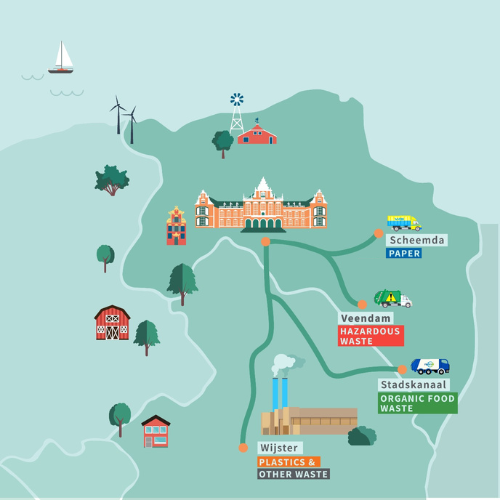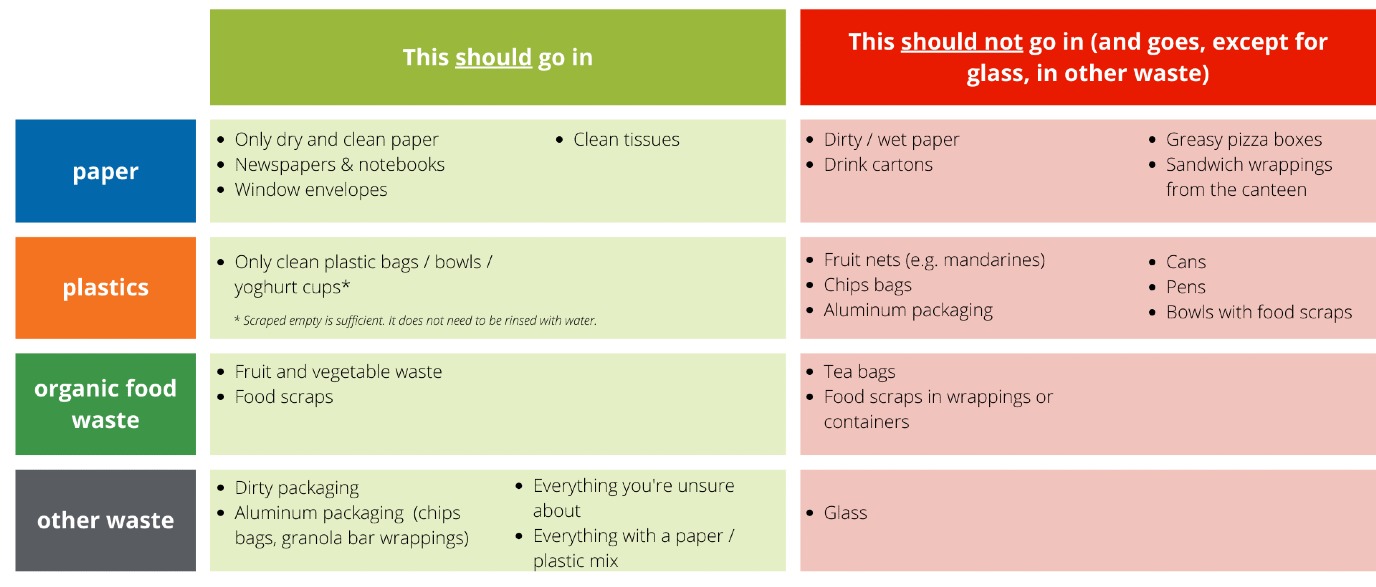Afvalscheiding bij de RUG
In maart 2021 is de RUG gestart met afvalscheiding bij de bron, door het plaatsen van de nieuwe afvaleilanden. Toch zijn hier nog steeds vragen over. Wat moet in welke bak? En waarom worden bakken gezamenlijk geleegd terwijl we het apart inzamelen? Op deze pagina vind je alle informatie over afvalscheiding bij de RUG, van inzameling tot verwerking.
Hoe verwerken we afval bij de RUG?
Binnen de RUG scheiden we ons afval in vijf verschillende soorten afvalstromen: papier, plastic, gft en etensresten en restafval. Er is ook sprake van gevaarlijk afval in de laboratoria, dit wordt uiteraard apart ingezameld.
In alle gebouwen van de RUG vind je afvaleilanden, dit zijn de gekleurde prullenbakken met daarop de verschillende afvalstromen. De bakken worden regelmatig geleegd. Omdat veel gebouwen niet geschikt zijn om met een grote ophaalbak de diverse afvalstromen apart in te zamelen, worden de zakken eerst in één grote bak gedaan. Daarna worden ze opnieuw per stroom gescheiden. Een uitzondering hierop zijn de stromen plastic en restafval. Deze twee worden naar dezelfde partij gebracht ter verwerking. Verder op deze pagina lees je waar elke afvalstroom heengaat.
Wat moet waar in?
In onderstaande tabel zie je wat er in welke bakken mag. Klik op de tekst onder de tabel om deze te vergroten.
Waar gaat het gescheiden afval heen?
Het recyclen en verwerken van afval willen we op een zo duurzaam mogelijke manier doen. De verschillende stromen afval die we verzamelen bij de RUG worden daarom alleen bij lokale partijen gerecycled of verwerkt.

Papier
Het papier uit de blauwe bakken wordt naar PreZero in Scheemda gebracht om gerecycled te worden. Papier wordt gerecycled door het te wassen en te versnipperen tot pulp, wat vervolgens gepresseerd wordt tot nieuw papier. Ook worden er nieuwe wc rollen gemaakt van oud papier.
Plastic
Het plastic afval wordt samen met restafval nagescheiden bij Attero in Wijster. Plastic kan gerecycled worden door het te smelten en vervolgens te spuiten of te persen tot nieuwe producten. Van plastic afval worden bijvoorbeeld nieuwe flessen gemaakt.
Gft & etensresten
Alle gft en etensresten wordt bij Renewi verwerkt. Van dit soort afval wordt compost gemaakt, een natuurlijk middel dat gebruikt kan worden om planten te bemesten.
Restafval
Restafval wordt samen met plastic nagescheiden bij Attero.
Restafval kan verwerkt worden door middel van verbranding, waarbij het afval wordt verbrand en de energie die vrijkomt wordt opgevangen. De restjes die na verbranding overblijven, kunnen deels gebruikt worden voor de aanleg van wegen.
Bekers (tot voor kort)
De RUG gebruikt sinds januari 2024 geen wegwerpbekers meer, studenten en medewerkers brengen hun eigen beker mee. Bij de meeste afvaleilanden zijn de bakken voor bekers dan ook weggehaald. De bakken worden nog wel hergebruikt. Bijvoorbeeld om herbruikbare bekers in te zamelen bij een evenement, die vervolgens worden schoongemaakt.
Wat kun jij zelf doen?
Afval scheiden doen we samen. Een paar praktische tips die jij toe kunt passen:
-
Probeer zo min mogelijk afval te produceren. Denk aan het hergebruiken van verpakkingen en andere dingen die je snel weg zou gooien.
-
Scheid bewust je afval door te kijken of je het in de goede bak gooit. Dit is belangrijk om de afvalstromen niet te ‘vervuilen’. Als er bijvoorbeeld teveel plastic tussen papier zit, of als papier te vet is en voorzien van voedselresten, kan dit niet bij het oud papier. Het recyclebedrijf moet eerst de vervuiling uit het gescheiden ingezamelde afval halen, voordat ze het afval kunnen verwerken. Dat kost tijd en geld en een deel van het afval kan hiermee onbruikbaar worden voor recycling.
-
Zorg dat bijvoorbeeld plastic bakjes schoon zijn als je ze in de plastic bak gooit. Dit hoeft niet brandschoon te zijn, maar zonder veel resten. Krijg je de resten er niet uit? Gooi het dan bij restafval.
-
Help mee met bewustzijn creëren.
Bij de RUG hebben we ambitieuze doelstellingen wat betreft afval: we willen onze hoeveelheid restafval verminderen en in 2026 moet al het restafval circulair zijn. Het doel is om de Universiteit te verduurzamen, dit beleid sluit aan bij onze waarden.
Waarom scheiden we afval?
-
Meer recyclen betekent minder afvalverwerking. Dit zorgt ervoor dat er ook minder broeikasgassen worden uitgestoten door afvalverwerking.
-
Lagere kosten afvalwerking: als we afval beter scheiden, is hetmakkelijker en goedkoper om te verwerken.
-
Grondstoffen sparen: als we afval goed scheiden, wordt het makkelijker om bepaalde materialen te hergebruiken of te recyclen.
-
Afval scheiden motiveert en creëert bewustwording.
Meest gestelde vragen
Gaat na de gescheiden inzameling al het afval weer op een hoop?
Nee, dat gaat het niet. Het is waar dat afval na de inzameling vaak op een centrale locatie terechtkomt, maar dit betekent niet dat het afval weer bij elkaar op een hoop wordt gelegd. In plaats daarvan wordt het gescheiden afval gesorteerd op basis van soort en samenstelling en vervolgens verwerkt op een manier die afhankelijk is van het type afval. Dit kan bijvoorbeeld recycling, hergebruik, verbranding, compostering of storten zijn.
Is gft apart inzamelen flauwekul?
Gft-afval bevat veel organische materialen waar compost van gemaakt kan worden, een natuurlijk middel dat gebruikt wordt om planten te bemesten. Door gft-afval te scheiden, zorgen we ervoor dat dit afval niet naar de stortplaats gaat, maar gecomposteerd wordt. Dit is beter voor het milieu, omdat het de hoeveelheid afval vermindert die in de grond terechtkomt en de hoeveelheid afvalverwerking die nodig is.
Bovendien helpt gft-scheiden ook om de hoeveelheid broeikasgassen te verminderen. Organisch afval dat naar de stortplaats gaat, kan daar gaan rotten en broeikasgassen produceren. Door gft te scheiden en te composteren in plaats van te storten, kunnen we de hoeveelheid broeikasgassen verminderen die door afval worden geproduceerd.
En wist je dat de afvalstroom gft en etensresten één van de belangrijkste is om te scheiden? Gooi je bijvoorbeeld gft-afval bij het restafval, dan is het lastig dit er uit te halen doordat het vaak nat en plakkerig is.
Kost afval scheiden meer dan het oplevert?
Het is goedkoper om gescheiden afval te verwerken, dan één hoop gemengd afval. Ingezameld papier, glas, metaal en textiel leveren geld op: daarmee gaan de kosten van het inzamelen en verwerken naar beneden. Het inzamelen en recyclen van gft tot compost en andere organische producten is goedkoper dan verbranden.
Is gescheiden inzamelen juist slechter voor het milieu?
Als we afval beter scheiden, kan een groter deel hergebruikt worden in plaats van dat het naar de stortplaats gaat. Dit is beter voor het milieu, omdat het de hoeveelheid afval vermindert die in de grond terechtkomt en de hoeveelheid afvalverwerking die nodig is. Bovendien kan het scheiden van afval ook leiden tot meer hergebruik en recycling. Dit vermindert de vraag naar grondstoffen.
Heb je vragen over het afvalbeleid van de RUG? Laat het weten via communicatie.facilitair@rug.nl.

